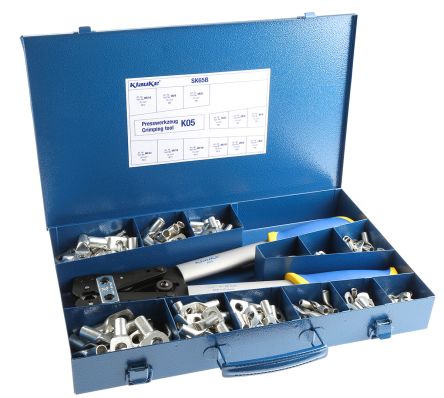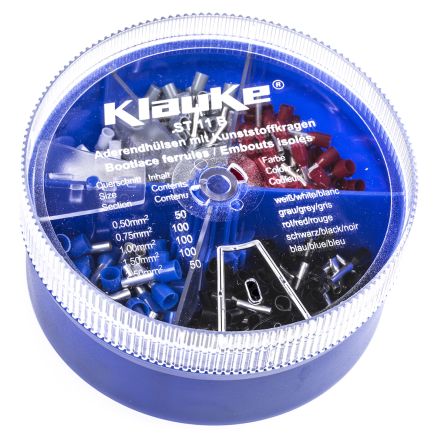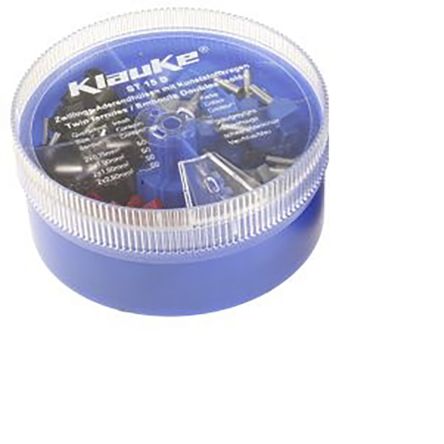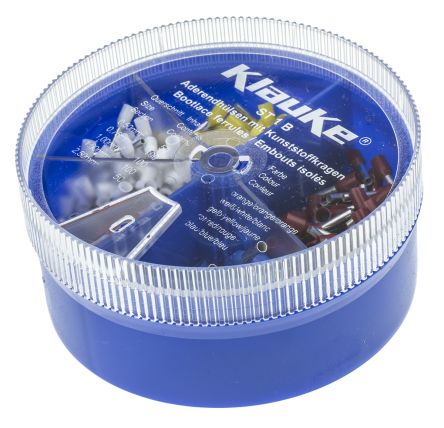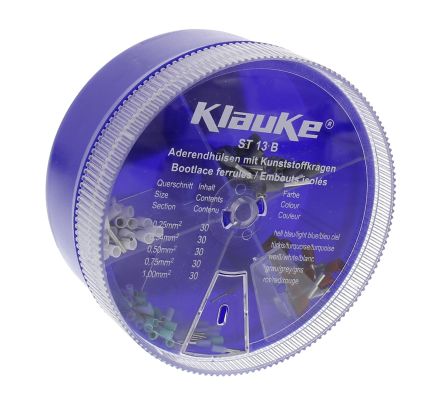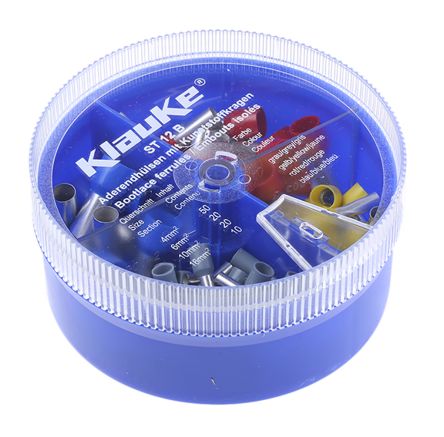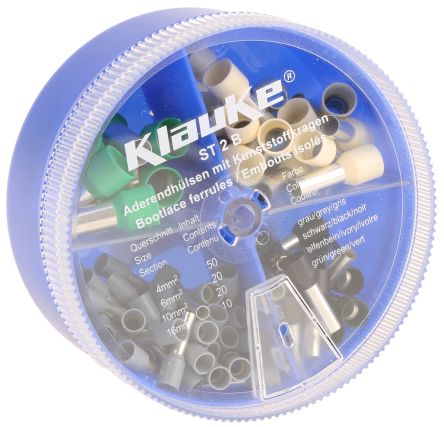- Automation & Control Gear
- Cables & Wires
- Enclosures & Server Racks
- Fuses & Circuit Breakers
- HVAC, Fans & Thermal Management
- Lighting
- Relays & Signal Conditioning
- Switches
- Batteries & Chargers
- Connectors
- Displays & Optoelectronics
- ESD Control, Cleanroom & PCB Prototyping
- Passive Components
- Power Supplies & Transformers
- Raspberry Pi, Arduino, ROCK, STEM Education & Development Tools
- Semiconductors
Klauke Crimping Kits
Crimping is a way of terminating strands of wire in order to connect them to external circuits, using a crimping tool to squeeze a wire hard enough to cold weld it to a given terminal. Crimp terminal kits consist of a crimping tool and various types of terminal.
The advantage of crimping is that it forms gas-tight connections, so there is less corrosion of the wire, and the joints are mechanically strong as there is no additional material used, as opposed to soldering.
How Do Crimp Terminal Kits Work?
There are broadly three steps to using crimp terminal kits:
- Insert the desired terminal into the crimping tool
- Insert the wire into the terminal
- Squeeze together the handles of the crimping tool to cold weld the terminal onto the wire
Types of Crimping Kits
Crimp kits come in a variety of configurations to accommodate different applications and skill levels:
- Basic Crimp Kits: These kits typically include a basic crimping tool and a selection of common terminals, suitable for DIY projects and light-duty applications.
- Advanced Crimp Kits: Designed for professional use, advanced kits often feature a more robust crimping tool with interchangeable dies to accommodate a wider range of terminal types and sizes.
- Specific-Use Crimp Kits: These kits are tailored for specific applications, such as automotive wiring, network cabling, or industrial machinery. They include specialised tools and terminals designed for those particular tasks.
Choosing the Right Crimping Kit
Selecting the right crimp kit depends on several factors:
- Wire Types and Sizes: Consider the types and gauges of wires you'll be working with. Ensure the kit's crimping tool and terminals are compatible with your wire sizes.
- Terminal Types: Different applications may require specific terminal types, such as ring terminals, spade terminals, or butt splice terminals. Choose a kit that includes the necessary terminals for your projects.
- Usage Frequency: If you'll be crimping frequently, invest in a high-quality, durable kit with a comfortable grip and ergonomic design. For occasional use, a basic kit may suffice.
- Features: Consider additional features that may be beneficial, such as interchangeable dies, ratchet mechanisms for consistent crimps, or built-in wire cutters and strippers.
Maintenance and Care Tips for Crimping Kits
To ensure your crimping kit remains in top condition and delivers reliable crimps for years to come, follow these maintenance tips:
- Keep it Clean: Regularly clean your electrical crimping tool kit to remove any dust, debris, or oil that can accumulate on the jaws or mechanism.
- Lubricate Moving Parts: Apply a light coat of lubricant to the moving parts of the crimping tool, such as the hinge and ratchet mechanism, to ensure smooth operation and prevent corrosion.
- Inspect for Wear and Tear: Periodically inspect the crimping jaws for signs of wear, such as burrs or misalignment. If any damage is detected, replace the jaws or consider a new tool.
- Store Properly: When not in use, store your crimping tool in a clean, dry place, preferably in its original packaging or a protective case.
Types of Crimp Terminals
Crimp terminals come in various types and configurations to suit different wiring needs:
- Ring Terminals: These terminals feature a closed-loop design, ideal for secure connections to studs, screws, or other threaded fasteners.
- Spade Terminals: With a flat, forked design, spade terminals provide a quick-connect/disconnect option for electrical connections.
- Butt Splice Terminals: These terminals are used to join two wires together, creating a seamless and reliable connection.
- Insulated and Non-Insulated Terminals: Insulated terminals feature a plastic sleeve that covers the metal connector, providing electrical insulation and protection against accidental shorts. Non-insulated terminals are more economical but require additional insulation in certain applications.
The choice of crimp terminal set depends on the specific requirements of your project, including wire gauge, connection type, and environmental conditions.
Industry Applications
Crimping is a widely used technique across various industries due to its reliability and efficiency:
- Discrete Manufacturing: Crimping is essential for connecting wires in electrical panels, machinery, and control systems in manufacturing environments.
- Process Manufacturing: In industries like chemical processing, pharmaceuticals, and food production, crimping ensures secure and reliable connections for instrumentation and control systems.
- Energy and Utilities: Crimping is used extensively in the power generation, transmission, and distribution sectors for connecting wires in switchgear, transformers, and other electrical equipment.
- Facilities and Intralogistics: In warehouses, distribution centres, and transportation systems, crimping is used for connecting wires in control panels, automation systems, and communication networks.
Your Trusted Crimping Kits Supplier & Manufacturer
RS is a leading distributor of electrical crimping tool kits and crimp terminal kits in Australia. We offer a wide selection of related products, such as crimp connectors and electrical spades from top brands, including Phoenix Contact, TE Connectivity, and RS PRO. For more information on our delivery services and fees, please refer to our Delivery page.
Explore the new look of the category page
7 Products showing for Klauke Crimping Kits
Popular Searches
Related links
- Crimp Tools
- RS PRO French Colour Coded Bootlace Ferrule Crimp terminal Kit
- A Complete Guide to Crimp Tools
- MECATRACTION Metal Electrician Box Crimp Terminal Crimp terminal Kit
- MECATRACTION Assorted Box with Tubular Lugs and Crimping Tool...
- Knipex Crimp Assortment Kit Crimp Crimp terminal Kit
- Weidmuller CRIMP-SET PZ 16 Bootlace Ferrule Crimp terminal Kit
- HellermannTyton 630 Pieces Insulated Terminal Crimp terminal Kit
